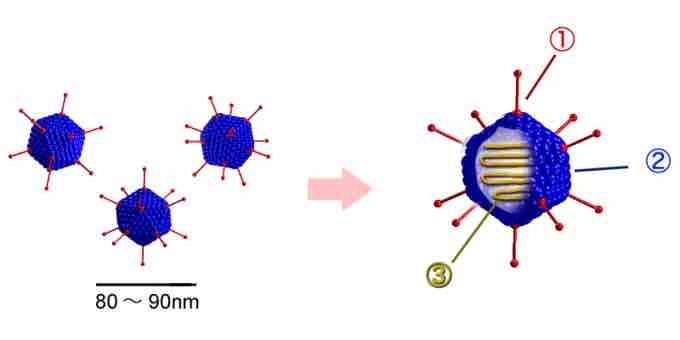Adenoviruses are medium-sized (90–100 nm), non-enveloped, icosahedral viruses composed of a nucleocapsid and a linear, double-stranded DNA (dsDNA) genome. There are 57 described serotypes in humans, which are responsible for 5–10% of upper respiratory infections in children, and many infections in adults as well.
Diversity
Viruses of the family Adenoviridae infect vertebrates, including humans. Among human-tropic viruses classification can be complex; there are 57 accepted human adenovirus types (HAdV-1 to 57) in seven species (Human adenovirus A to G). Different species/serotypes are associated with different conditions:
- respiratory disease (mainly species HAdV-B and C)
- conjunctivitis (HAdV-B and D)
- gastroenteritis (HAdV-F types 40, 41, HAdV-G type 52)
In addition to human viruses, Adenoviridae can be divided into five genera: Mastadenovirus, Aviadenovirus, Atadenovirus, Siadenovirus, and Ichtadenovirus.
Genome
Structurally, adenoviruses represent the largest non-enveloped viruses. They possess non-segmented dsDNA genomes between 26 and 45 Kbp, significantly larger than other dsDNA viruses. The virion also has unique "spike" or fiber associated with each penton base of the capsid that aids in attachment to the host cell via host cell surface receptors .

Adenovirus Structure
1) Penton capsomeres 2) Hexon capsomeres 3) Viral genome (linear dsDNA)
Viral Entry and Replication
Entry of adenoviruses into the host cell involves two sets of interactions between the virus and the host cell. First, entry into the host cell is initiated by the knob domain of the fiber protein binding to a host cell receptor, either CD46 for the group B human adenovirus serotypes, or the coxsackievirus adenovirus receptor for all other serotypes. Next, a specialized motif in the penton base protein interacts with αv integrin, stimulating internalization of the adenovirus via clathrin-coated pits, resulting in entry of the virion into the host cell within an endosome.
Following internalization, the endosome acidifies, which alters virus topology, causing capsid components to disassociate. These changes, as well as the toxic nature of the pentons, result in the release of the virion into the cytoplasm. With the help of cellular microtubules, the virus is transported to the nuclear pore complex, where viral gene expression can occur.
The adenovirus life cycle is separated by the DNA replication process into two phases: an early and a late phase. In both, a primary transcript that is alternatively spliced to generate monocistronic mRNAs compatible with the host's ribosome is generated, allowing for the products to be translated.
The early genes are responsible for expressing mainly non-structural, regulatory proteins. The goal of these proteins is threefold: to alter the expression of host proteins necessary for DNA synthesis; to activate other viral genes (such as the virus-encoded DNA polymerase); and to avoid premature death of the infected cell by the host-immune defenses (blockage of apoptosis, blockage of interferon activity, and blockage of MHC class I translocation and expression).
The late phase of the adenovirus lifecycle is focused on producing sufficient quantities of structural protein to pack all the genetic material produced by DNA replication. Once the viral components have successfully been replicated, the virus is assembled into its protein shells and released from the cell as a result of virally induced cell lysis.
Transmission
Adenoviruses are unusually stable to chemical or physical agents and adverse pH conditions, allowing for prolonged survival outside of the body and water. Adenoviruses are spread primarily via respiratory droplets; however, they can also be spread by fecal routes.
Humans infected with adenoviruses display a wide range of responses, from no symptoms at all to the severe infections typical of Adenovirus serotype 14. In the past, U.S. military recruits were vaccinated against two serotypes of adenoviruses, with a corresponding decrease in illnesses caused by those serotypes. Although the vaccine is no longer manufactured for civilians, military personnel can receive the vaccine as of 2014.
Infections
Viral transmission occurs primarily through expectorate, but can also be transmitted via contact with infected objects. Most adenovirus infections affect the upper respiratory tract. These often show up as conjunctivitis, tonsillitis, ear infection, or croup. Adenoviruses, types 40 and 41 can also cause gastroenteritis. A combination of conjunctivitis and tonsillitis is particularly common with adenovirus infections. Some children (especially small ones) can develop adenovirus bronchiolitis or pneumonia, both of which can be severe.
Utilization in Treatment of Unrelated Diseases
Adenovirus is used as a vehicle to administer targeted therapy in the form of recombinant DNA or protein. Specific modifications on fiber proteins are used to target Adenovirus to certain cell types; a major effort is made to limit hepatotoxicity and prevent multiple organ failure. Adenovirus dodecahedron serves as a potent delivery platform for foreign antigens to human myeloid dendritic cells (MDC), and is efficiently presented by MDC to M1-specific CD8+ T lymphocytes.